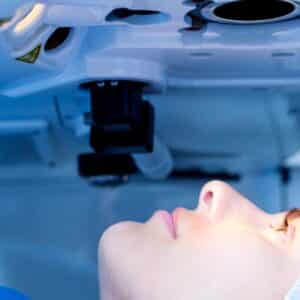What is LASIK and How Does it Work?
LASIK, or laser-assisted in situ keratomileuses, is a laser eye surgery used to correct specific vision problems. It is a popular procedure because it is generally safe, effective, and has a quick recovery time.
During a LASIK procedure, a thin flap is made in the cornea, the clear outer layer of the eye. The flap is then lifted, and an excimer laser is used to reshape the underlying corneal tissue. The laser removes a precise amount of tissue, depending on the patient’s specific vision problem. The flap is then replaced and allowed to heal naturally.
LASIK is typically used to treat nearsightedness (myopia), farsightedness (hyperopia), and astigmatism. It can also be used to treat presbyopia, a condition that occurs as people age and involves difficulty seeing objects up close.
The procedure is usually performed on an outpatient basis and takes about 15 minutes per eye. Most patients experience a significant improvement in their vision immediately after the procedure, although it may take several days or weeks for the full effects to be seen.
LASIK is generally considered a safe and effective way to correct vision problems, but like any surgical procedure, it does carry some risks. These can include dry eye, glare or halos around lights, and the need for additional laser treatments. It is essential to discuss the potential risks and benefits of LASIK with an eye doctor before deciding to undergo the procedure.
So, this is all about LASIK, a laser eye surgery that helps correct vision problems. LASIK has helped many people improve their vision and reduce or eliminate their need for glasses or contact lenses. If you are considering LASIK, you must consult an eye doctor to determine if it is the right choice.
How Long Does LASIK Last?
The long-term results of LASIK are generally perfect, with most patients experiencing a significant improvement in their vision immediately after the procedure. In a study of over 900 patients who underwent LASIK, 96% of patients achieved 20/40 vision or better, considered the minimum level of vision required to obtain a driver’s license without the aid of glasses or contact lenses.
While most patients experience stable vision after LASIK, it is essential to note that the procedure does not stop the natural aging process of the eye, and some patients may experience changes in their vision over time.
These changes can be due to factors such as the development of presbyopia (difficulty seeing objects up close) or the onset of cataracts.
It is also important to note that LASIK is not a permanent solution for vision problems and that the procedure carries some risks, including dry eye, glare or halos around lights, and additional laser treatments. It is essential to discuss the potential risks and benefits of LASIK with an eye doctor before deciding to undergo the procedure.
Overall, the long-term results of LASIK are generally excellent, with most patients experiencing a significant improvement in their vision. However, it is crucial to be aware that the procedure does not stop the eye’s natural aging process and that some patients may experience changes in their vision over time.
Adjustments After LASIK Surgery
LASIK is a popular procedure because it is generally safe, effective, and has a quick recovery time.
After LASIK surgery, it is common for patients to experience some adjustments as their eyes heal and become accustomed to their new vision. These adjustments can include the following:
- Blurred vision: It is normal to have some blurriness immediately after LASIK surgery, as the cornea is swollen and the eye is trying to adjust to its new shape. This usually improves within a few days to a week.
- Dry eye: Some patients experience dry eye after LASIK surgery, which can cause discomfort and fluctuating vision. This can be managed with artificial tears or other lubricating eye drops.
- Glare and halos: Some patients may experience glare or halos around lights, especially at night, in the first few weeks after LASIK surgery. These symptoms usually resolve on their own over time.
- Sensitivity to light: Some patients may experience increased sensitivity to light after LASIK surgery. Wearing sunglasses or a hat can help protect the eyes from bright sunlight.
Following the post-operative instructions provided by your eye doctor after LASIK surgery is essential to ensure the best possible recovery and results. If you have any concerns or questions, discuss them with your eye doctor.
Maintaining Good Habits After LASIK Surgery
After LASIK surgery, it is crucial to maintain good habits to help ensure the best possible outcomes and maintain the health of your eyes. These habits include:
- Protect your eyes from injury: Wear protective eyewear when engaging in activities that can cause eye injury, such as sports or using power tools.
- Follow your eye doctor’s instructions: It is essential to follow your eye doctor’s post-operative instructions carefully to ensure a smooth recovery and the best possible results.
- Use lubricating eye drops as needed: If you experience dry eye after LASIK surgery, your eye doctor may recommend using artificial tears or other lubricating eye drops to help alleviate discomfort and maintain healthy eyes.
- Avoid rubbing your eyes: It is important to avoid rubbing your eyes after LASIK surgery, as this can cause irritation and disrupt the healing process.
- Attend follow-up appointments: Your eye doctor will likely schedule follow-up appointments to monitor your progress after LASIK surgery. It is essential to attend these appointments as scheduled.
By following these simple habits, you can help ensure the best possible outcomes and maintain the health of your eyes after LASIK surgery.
Selecting an Eye Doctor for the LASIK Procedure
When selecting an eye doctor for a LASIK procedure, it’s essential to do your research and choose a qualified and experienced provider. Here are a few things to consider when selecting an eye doctor for LASIK:
- Board certification: Make sure the eye doctor is board-certified by the American Board of Ophthalmology. This ensures that the doctor has received the necessary training and education to practice ophthalmology.
- Experience: Choose a doctor who has performed a significant number of LASIK procedures and has a track record of good outcomes.
- Technology: Look for a provider who uses the most advanced technology, such as wavefront-guided LASIK and femtosecond lasers, as these can increase the accuracy and predictability of the procedure.
- Consultation: Schedule a consultation with the doctor to discuss your specific needs and goals and to ask any questions you may have about the procedure.
- Comfort level: It’s essential to feel comfortable with the eye doctor you choose, as you will be entrusting them with your vision. Don’t be afraid to shop around and consult with multiple providers before making a decision.
It’s also a good idea to check with your insurance provider to see if LASIK is covered under your plan and, if so, which providers are in your network.
What To Expect When Having LASIK?
Here’s what to expect when having LASIK:
- Pre-operative evaluation: Before the procedure, you will have a thorough eye exam to determine if you are a good candidate for LASIK. The eye doctor will also discuss the risks and benefits of the procedure with you.
- Numbing the eye: On the day of the procedure, the eye doctor will numb the eye with anesthetic drops to minimize discomfort.
- Creating the corneal flap: The first step of the LASIK procedure involves creating a thin flap on the surface of the cornea. This can be done using a laser (femtosecond laser) or a surgical instrument (microkeratome).
- Reshaping the cornea: Once the corneal flap is created, the eye doctor will use a laser to reshape the underlying cornea to correct your vision.
- Closing the flap: After the laser reshapes the cornea, the eye doctor will reposition the corneal flap and smooth it down.
- Post-operative care: After the procedure, you will need to rest for a few hours and may experience some discomfort, such as dryness, itching, or a feeling of something in your eye. Your eye doctor will provide you with eyedrops to help with any pain and to prevent infection.
Most people experience a significant improvement in their vision within a few days of the procedure, although it may take a few weeks for the vision to stabilize completely.
LASIK Complications?
Some possible complications of LASIK include:
- Dry eyes: Dry eye syndrome is a common side effect of LASIK and can cause discomfort, blurred vision, and increased sensitivity to light. This usually resolves within a few weeks, but in some cases, it may be a long-term issue.
- Infection: While the risk of infection is low, it’s essential to follow your eye doctor’s instructions for post-operative care, including the use of prescribed eyedrops, to help prevent infection.
- Under- or overcorrection: In some cases, the laser may not remove enough tissue or too much tissue, resulting in under- or overcorrection of the vision problem. This can usually be corrected with additional surgery.
- Flap complications: The corneal flap created during the LASIK procedure is delicate and can be damaged if not handled properly. This can result in complications such as flap displacement, wrinkles, or folds in the flap.
- Halos and glare: Some people may experience halos or glare around lights, particularly at night, after LASIK. These side effects usually resolve within a few weeks, but in some cases, they may be long-term.
It’s important to discuss the potential risks and complications of LASIK with your eye doctor before the procedure, so you can make an informed decision about whether it’s right for you.
Is LASIK Eye Surgery Painful?
LASIK eye surgery is generally not painful. During the procedure, the eye doctor will numb the eye with anesthetic drops, so you should not feel any discomfort. Some people may experience a mild sensation of pressure during the procedure, but this is typically not painful.
After the procedure, you may experience some discomfort, such as dryness, itching, or a feeling of something in your eye. This is normal and should resolve within a few days. Your eye doctor will provide you with eyedrops to help with any discomfort and to prevent infection.
It’s important to follow your eye doctor’s instructions for post-operative care, including the use of eyedrops and the wearing of protective eyeglasses, to help ensure a smooth recovery. If you experience any significant pain or discomfort after the procedure, or if you have any concerns, be sure to contact your eye doctor for guidance.
Investigating Other Vision Correction Options
If you are considering vision correction surgery, it is essential to research and consider all your options before making a decision. In addition to LASIK, several other types of vision correction surgery may be appropriate for you, depending on your specific vision problem and overall health.
Some other options include the following:
- PRK: Photorefractive keratectomy (PRK) is a type of laser eye surgery similar to LASIK, but it does not involve the creation of a corneal flap. PRK may be a good option for people with thin corneas or certain occupations or hobbies that may make them more prone to eye injuries.
- ICL: Implantable contact lenses (ICLs) are small, artificial lenses placed inside the eye to correct vision problems. ICLs may be a good option for people who are not suitable candidates for LASIK or PRK due to certain factors, such as thin corneas or very high levels of nearsightedness.
- Refractive lens exchange: Refractive lens exchange (RLE) is a surgical procedure in which the eye’s natural lens is removed and replaced with an artificial lens to correct vision problems. RLE may be a good option for people who are not suitable candidates for LASIK or PRK due to certain factors, such as thin corneas or very high levels of nearsightedness.
- Cataract surgery: Cataract surgery is a procedure in which the eye’s natural lens is removed and replaced with an artificial lens to correct vision problems caused by cataracts. Cataract surgery may be an option for people who have developed cataracts and are experiencing vision problems.
It is essential to discuss the potential risks and benefits of each of these options with an eye doctor before deciding which type of vision correction surgery is right for you.






